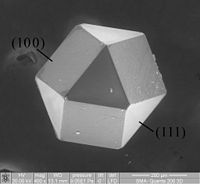
Photo from wikipedia
Lithium-titanium-oxide (Li4Ti5O12, LTO) is unique among battery materials due to its exceptional cyclability and high rate capability. This performance is believed to derive at least partly from the occupational disorder… Click to show full abstract
Lithium-titanium-oxide (Li4Ti5O12, LTO) is unique among battery materials due to its exceptional cyclability and high rate capability. This performance is believed to derive at least partly from the occupational disorder introduced via mixed Li/Ti occupancy in the LTO spinel-like structure. We explore the vast configuration space accessible during high-temperature LTO synthesis by Monte Carlo sampling and indeed find lowest-energy structures to be characterized by a high degree of microscopic inhomogeneity. Dynamical simulations in corresponding configurations reveal the dominant fraction of Li ions to be immobile on nanosecond time scales. However, Ti antisite-like defects stabilized by the configurational disorder give rise to a novel correlated ion diffusion mechanism. The resulting fast but localized diffusion could be a key element in the sudden rise in conductivity found in LTO in the early stages of charging and questions the validity of ion mobility measurements for this and other configurationally disordered materials.
Journal Title: Nano letters
Year Published: 2017
Link to full text (if available)
Share on Social Media: Sign Up to like & get
recommendations!